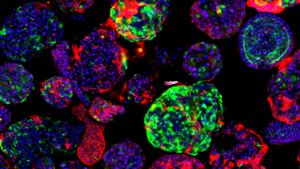FCF is pleased to announce the award of a grant to Benedetta Artegiani, PhD of the Princess Maxima Center for Pediatric Oncology (Utrecht, The Netherlands) and Delilah Hendriks, PhD of the Hubrecht Institute (Utrecht, The Netherlands). This new 2 year grant, entitled “Unravelling the tumorigenic requirements of fibrolamellar carcinoma using novel engineered DNAJB1-PKRACAfus and BAP1KO; PRKAR2AKO human liver organoid models“, is designed to extend that team’s previous FCF-funded work creating synthetic organoids of FLC. The hope is that the study will improve our understanding of the formation of FLC tumors by identifying potential drivers of FLC that act alongside the fusion gene, while also creating new disease models that could be useful for the testing and development of FLC treatments.
In comparison with more common cancers, research models of FLC have been extremely limited. This is especially true for human FLC cells in culture, a centerpiece of many analytical studies. Drs. Artegiani and Hendriks have addressed this problem by creating “synthetic” models of FLC as organoids (3D mini-organs). Specifically, they developed both liver cell organoids and techniques to genetically modify these organoids using CRISPR technology which can introduce genetic changes into normal cells.
In previous work funded by FCF, these investigators “knocked-in” the DNAJB1-PRKACA fusion gene in organoids. They found that this altered the normal liver cells to resemble FLC cancer cells in many respects. However, these gene-modified organoids did not fully transform into malignant cancer cells. While the DNAJB1-PRKACA fusion is now understood to be the driver of FLC, and essential for the growth and survival of FLC tumor cells, there have been suggestions that the fusion gene alone does not suffice for the complete transformation of normal cells into a robust FLC-like cancer.
A major goal of this study is to determine whether the introduction of additional mutations in cells along with the DNAJB1-PRKACA fusion can generate biological features that more closely resemble fully transformed FLC cancer cells.
To learn more about the science behind this team’s work, please read the article the team published in Nature Communications in May 2023.

